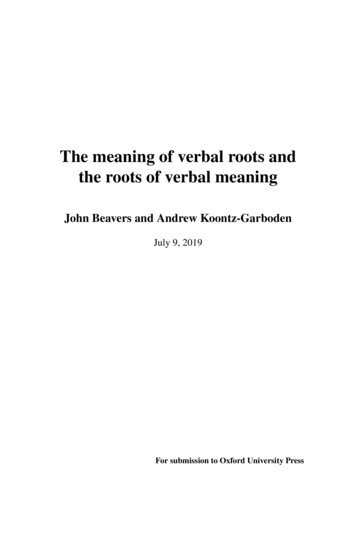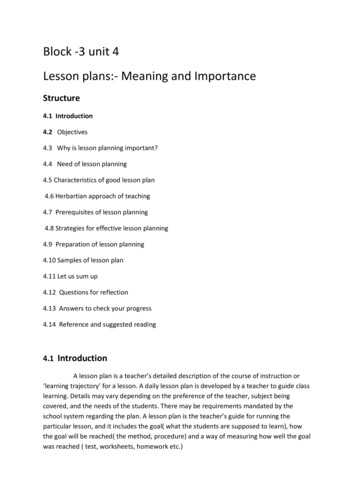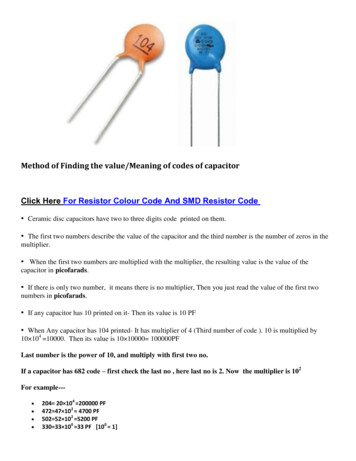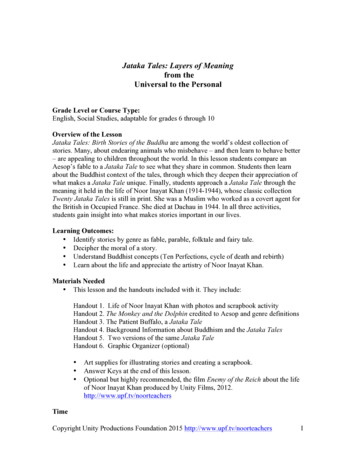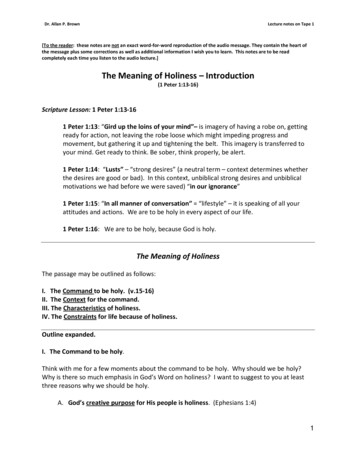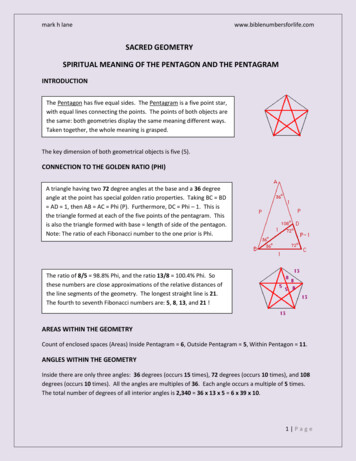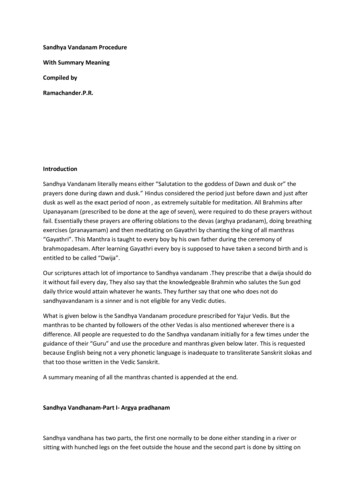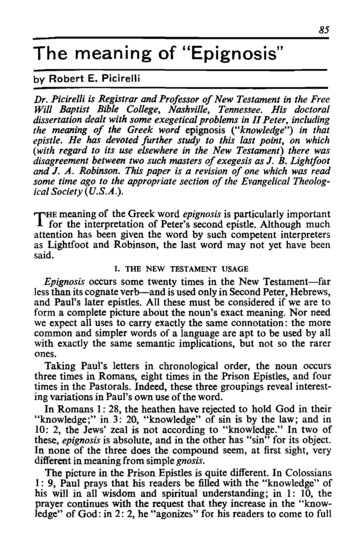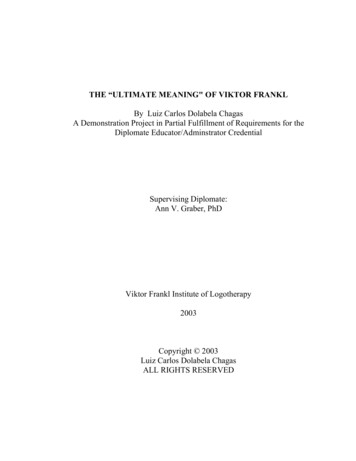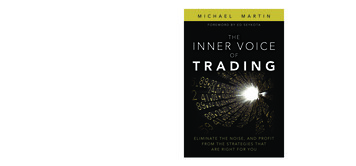
Transcription
The Inner Meaning Of The Tarot
The Inner Meaning Of The TarotRobert M. Haralick
The Inner Meaning Of The TarotRobert M. Haralick27 Tara DrivePomona, New Yorkharalick@aim.com
This book was prepared with LATEX, and published from camera-readypages prepared by the author on a laser printer. The Hebrew font was designed by the author in postscript and converted to metafont by VisvanathanRamesh.Copyright c 1992 by Robert M. Haralick. All rights reserved. Printed inthe United States of America. Except as permitted under the United StatesCopyright Act of 1976, no part of this publication may be reproduced ordistributed in any form or by any means or stored in a data base or retrievalsystem, without the prior written permission of the publisher.
The Inner Meaning of the rammaton and The Divine Nature of Change7Overview17The Colors23The Fool27The Magician39The High Priestess55The Empress75The Emperor93The Hierophant111The Lovers135The Charioteer153The Woman of Strength175The Hermit191The Wheel of Fortune207The Woman of Justice229The Hanged Man249The Death Rider267
ContentsvThe Angel of Temperance285The Devil305The Tower325The Star Maiden345The Moon367The Sun389Judgement409World Dancer425Index440
Contents1AcknowledgementWorking this material into a book has been a humbling experience. There isso much that had to be learned, especially for a technical person who worksfor a living with linear symbol strings rather than with visual symbolism.And there is so much more that is yet to be learned, that it is apparent thatthis learning will never end.Although the preparation of this book has taken a fair amount of time,I have had fastastic help. Gene started me on this path, showing me thatit was possible to organize a small group for the purpose of experiencing,learning, and growing. Michael, Laurel and Raeah have had great fortitudein bearing with the frustrations I liberally provided them as I struggled withmy own ego’s resistance to their efforts to teach me. Perhaps their effortshave not been entirely wasted.Recognizing the Tarot archetypes in oneself is not always so easy. BecauseHolly and Mark each have lived aspects of many of the Tarot archetypes,their sharing of their experiences always enlightened me. For I saw reallife illustrations in them, even when they themselves did not recognize it.More importantly, they challenged me with their questions and directly orindirectly answered my own questions. But most of all they had faith thatI had the ability to select, organize, and interpret the Tarot in a way thatwould benefit all of us. It was because of their unspoken faith that I foundthe time and energy to do what was necessary to assemble the book. Tothem I am enormously grateful. Thankyou so much for what you have givento me.
Contents2
Contents3IntroductionThe Inner Meaning of the Tarot explores the meaning and symbolism of theMajor Arcana of the Rider and the B.O.T.A Tarot decks. Inner meaningrefers to the occult, mystical and hidden meaning and not to the ordinarydivination meaning.The basis for the exploration are the books written by Case, D’Agostino,Eden, Javane and Bunker, Moore, Nichols, Oribello, Sharman-Burke, Ussher,and Waite. On occasion other writers are quoted such as Arien, Connolly,Wanless, Lady Harris, and Sorer. They sometimes have something to saythat fits in with the interpretations of the B.O.T.A. and Rider Tarot decks,even though they may have been discussing one of the other Tarot decks.Each of the above authors has a slightly different point of view and aslightly different emphasis. By selecting what they write which is most pertinent to the inner meaning from the Tarot and by juxtaposing what theywrite, an all-around and yet deep form of the Tarot meaning emerges. Thedepth and breadth of this kind of juxtaposition has the possibility of evenexceeding that contained in each of the original writings.Not only are the specific symbols of each card described, but the meaningscorresponding to them are discussed in a language very close to the languageused by various authors writing about them. In addition to the specificsymbols, a general discussion for each Major Arcana as given by the authorsare quoted. Finally, the meanings we have integrated from our own studyare given. These meanings center on the deepest spiritual level.Because the teachings of the Tarot are teachings about Godliness, abouthow we can manifest Godliness in our lives by our handling of the changewe encounter and produce ourselves, a special discussion section of selectedquotes on the Tetragrammaton and change is put immediately after theoverview on the Tarot and just before the concentrated material on eachof the Major Arcana.In working with this book, read the spiritual level first and the generaldiscussion quotes second. Then while examining the Tarot cards read thesymbolism particulars third. Finally, return back and read to the spirituallevel meaning.It is our hope that the organization of the material selected and collectedfrom a variety of authors, authors having multiple of points of views, will act
Contents4as a catalyst helping the reader understand the meanings of the Tarot. Depththat one author has is in one area is often complemented by the depth ofanother author in another area. Thus this arrangement balances and deepenseach author’s insights. As well it can serve as the jumping off point to furtherreading and studying of the complete writings of each of our commentators.
Contents5References[1] Angeles Arrien, The Tarot Handbook, Arcus Publishing Company,Sonoma California, 1987.[2] Paul Foster Case, The Tarot, Macoy Publishing Company, Richmond,Virginia, 1975.[3] Eileen Connolly, Tarot, Vol I and II, New Castle Publishing CompanyInc., North Hollywoood, California, 1979.[4] Joseph D’Agostino, Tarot, Samuel Weiser, Inc. York Beach, Maine, 1985.[5] Eden Gray, A complete Guide to the Tarot, Crown Publishers, Inc., NewYork, 1970.[6] Lady Harris, Explanation in the Rider Tarot Deck, U.S. Games Systems,Inc., Stamford, Connecticut.[7] Faith Javane and Dusty Bunker. Numerology and The Divine Triangle,Para Research Inc., A Division of Schiffer Publishing, Ltd. West Chester,Pennsylvania, 1980.[8] Daphna Moore, The Rabbi’s Tarot, Huges Hensahw Publications, Lakewood, Colorado, 1987.[9] Sallie Nichols, Jung and Tarot Samuel Weiser, Inc. York Beach, Maine,1988.[10] William Alexander Oribello, The Sealed Magical Book of Moses, InnerLight Publications, New Brunswick, New Jersey, 1986.[11] Juliet Sharman-Burke, The Complete Book of Tarot, St. Martin’s Press,New York, 1986.[12] G.H. Soror, “The Tarot Trumps” in Robert Wang, An introduction tothe Golden Dawn Tarot, Samuel Weiser, Inc., York Beach, Maine, 1978.[13] Arland Ussher, The XXII Keys of the Tarot, The Dolmen Press, Dublin,1970.
Contents6[14] Arthur Edward Waite, The Pictorial Key to the Tarot, U.S. Games Systems, Inc. Stamford Connecticut, 1989.[15] James Wanless, New Age Tarot, Merril-West Publishing, Carmel, California, 1987.
The Tetragrammaton and Change7The Tetragrammaton and The DivineNature of ChangeThe Tetragrammaton is the unpronounceable name of God, dedi. The fourletters stand for the four worlds: the world of emanation, the world of creation, the world of formation, and the world of action. Think for a momentwhat these four worlds mean. With respect to us, the world of emanationis the world through which God gives us the gift of existence and life. Werealize this gift by our consciousness and free will. The world of creation isthe world in which this gift manfests through our ability to think and reason.The world of formation is the world by which what is in our consciousnesscan get expressed through our emotions. The world of action is the worldwhere we act in a way consistent with our emtions causing change in physicalexistence. In an analogous way, the thought of the Divine mainfests throughthese four worlds, for everything in existence, with its particular level of consciousness, free will, ability to think and reason, express emotion, and actcauses change in existence.Physical existence is just the carrier, the medium the Divine created, bywhich the Divine thought gets expressed. So physical existence is just theappearance. The thought, itself, is the essence. The essence is never thecarrier. The carrier is only the appearance.Zalman writes:The meaning of the Tetragrammaton is “that which calls everything into being” (lkd z dedn. Now dedn is the simple presenttense. The letter Yod (i) is substituted for the letter Mem (n)giving the name dedi. The prefix Yod (i) added to the stem dedindicates not only a present, but a continuous action as Rashiremarks in his comment to the verse: ‘In this manner used Jobto do all the days” (Job I 5). The Tetragrammaton, then, represents the Life which flows down actually at every moment untoall creatures and calls them forth at each moment out of nothingness.11Shneur Zalman, The Portal of Unity and Faith in Raphael Ben Zion, An Anthology ofJewish Mysticism (New York: The Judaica Press, 1981), p. 95-96.
The Tetragrammaton and Change8The result of the Divine thought is something that comes into and acts inphysical existence. We perceive this coming into physical existence as changing when we beome aware of it in the physical world. Something happenswhich was not there before. Something is different. The changing we ourselves undergo is our becoming. Our becoming is our being.Our world, therefore, is a changing world. The world is not constant.We are part of this changing world. We encounter change. We change. Weinitiate change. And we have to adapt to the change initiated by others.Adapting means that we too have to change in ways that we did not anticipate. Our world is a world of surprises: surprises that are given to us andsurprises that we give to others.These surprises come when our comfortable state of being has becomecompleted in time. This means that just when we are comfortable, then wefind there is Change. But within us, our ego likes security. Security meansconstancy in existence, in appearance. Constancy is having. But constancyis not in the world of action. Constancy in the world of action is an illusion.The beingness which we seek is cannot be found in appearance. This isbecause the beingness is in the becoming. The becoming is the essence for itis the pathway toward God.Becoming means that the freedom that we have must be utilized to initiatechange and to adapt to change in a way that moves us closer to God. Thisadaptation manifests in the world of action. But this is only its appearance.The essence of this becoming is in our relationship to God.The cycle can be easily described. Godly essence gives rise to changingappearance, which is a carrier for the expression of the essence. We respondto changing appearance by our becoming: changing our thoughts, words, andactions. This response is our expression of an essence. The response itselfis also carried by a changing appearance. But the appearance is not theessence for us either. This essence which is expressed through the changingappearance of our becoming, is that which brings us to God.To emphasize this point of view, we will discuss change in its essence,which we denote by Change. There are two ways in which we can participatein Change: by playing a finite game or by playing an infinite game. Whenwe play a finite game we are finite players. When we play an infinite game,we are infinite players.To encourage Change is to participate in it. To encourage Change in
The Tetragrammaton and Change9oneself is to play an infinite game. To participate in Change is to be surprised.To be surprised is to move boundaries, remove limitations and experience theunexpected.As Carse says, this means thatBecause infinite players prepare themselves to be surprised by thefuture, they play in complete openness. It is not an openness as incandor, but an openness as in vulnerability. It is not a matter ofexposing one’s unchanging identity, the true self that has alwaysbeen, but a way of exposing one’s ceaseless growth, the dynamicself that has yet to be. The infinite player does not expect onlyto be amused by surprise, but to be transformed by it.2The infinite player plays for the essence, which is never to play in orderto accomplish something. The infinite player plays in order that the gamebe infinitely continued, that the game never end. Therefore, the rules changein the course of the game. In contrast, the finite player plays to accomplishsomething that he might be declared the winner and the game be ended.Therefore, the rules of the game do not change and because they do notchange, the game has been internally limited. That is why it is called a finitegame.When the infinite player moves boundaries and experiences surprise theinfinite player discovers thatthe infinite play of life is joyous. Infinite play resounds throughout with a kind of laughter. It is not a laughter at others whohave come to an unexpected end, having thought they were goingsomewhere else. It is laughter with others with whom we havediscovered that the end we thought we were coming to has unexepectedly opened. We laugh not at what has surprisingly cometo be impossible for others, but over what has surprisingly cometo be possible with others. 3To suppress Change in oneself is to play a finite game. Though the finiteplayer suppresses Change in himself, the finite player plays to surprise the23James Carse, Finite and Infinite Games (New York: Ballantine Books, 1986), p. 23.ibid. p. 31.
The Tetragrammaton and Change10opponent. For when the opponent has been sufficiently surprised, the finitegame ends and the surpriser is declared the winner.This means thatFinite players must appear to be something other than what theyare. Everything about their appearance must be concealing. Toappear is not to appear. All the moves
On occasion other writers are quoted such as Arien, Connolly, Wanless, Lady Harris, and Sorer. They sometimes have something to say that fits in with the interpretations of the B.O.T.A. and Rider Tarot decks, even though they may have been discussing one of the other Tarot decks. Each of the above authors has a slightly different point of view and a slightly different emphasis. By selecting .
